Sandra Byrd's Blog, page 14
May 24, 2016
British Blooms and Books Giveaway
Hello, gentle reader, and welcome to the first annual British Blooms and Books giveaway! This week, we’d like to celebrate the Royal Horticultural Society’s Chelsea Flower Show. After enjoying this post, please visit each of the other five authors’ blogs (links provided below) and, after a bit of reading fun, follow one simple instruction and then leave a comment on each blog. You’ll be entered to win a fabulous, British Blooms and Books prize. (US winners only, please, due to shipping the petit fours.) Enjoy, and thank you for stopping by!

Rose Red My boyfriend had secretly purchased 50 long-stemmed red roses. The catch? They were affordable only because the stems were thoroughly studded with thorns. Undaunted, he sat up all night, a bucket of prickly beauties before him, a pruner in one hand, and a John Wayne movie on the TV. The following day was my birthday. The man who’d shorn all those roses so I could have a fragrant treasure, without pain, is now my husband. Since then, red roses have held unmatched importance in my own personal flower language.
My boyfriend had secretly purchased 50 long-stemmed red roses. The catch? They were affordable only because the stems were thoroughly studded with thorns. Undaunted, he sat up all night, a bucket of prickly beauties before him, a pruner in one hand, and a John Wayne movie on the TV. The following day was my birthday. The man who’d shorn all those roses so I could have a fragrant treasure, without pain, is now my husband. Since then, red roses have held unmatched importance in my own personal flower language.
The English, of course, are known for their roses. They have long cultivated old varieties and hybrid new ones, for example, the Diana, Princess of Wales. Roses are so common and popular in English culture that “she’s an English rose” is a noted phrase used to describe Englishwomen.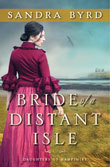 In my book, Bride of a Distant Isle, the heroine, Annabelle, is part Maltese, part English, and has dark hair. I chose the rose, Dark Lady, to represent her because the red rose is Annabel’s favorite. Here’s an excerpt from the book:
In my book, Bride of a Distant Isle, the heroine, Annabelle, is part Maltese, part English, and has dark hair. I chose the rose, Dark Lady, to represent her because the red rose is Annabel’s favorite. Here’s an excerpt from the book:
“Would you care to dance?” he asked.
I toyed with the idea of letting my Maltese half answer, saying, ‘I have been waiting for an hour or more for you to propose this very thing’, but my English heritage won. “I would be delighted.” I touched the velvety roses in the vase as we stood. “Red roses are my favorite flower.”
He led me to the dance floor as the orchestra began to play. “Why red roses?”
I smirked. Some playfulness must be allowed, after all. “A lady must keep some things secret.”
“A challenge, Miss Ashton, and one I gladly accept!” One hand reached round my back, and the other led the dance.
I hope you’ll read the book to see how Captain Dell’Acqua answered the challenge, and to find out if he won our Dark Lady’s heart. Please sign up for my newsletter (if you’re already signed up, just let me know in the comments). Then, comment below letting us know what you like best about books set in Britain, and easy-peasy, you’ll be entered in the sweepstakes to win the grand prize!

 One grand prize winner who comments on each of the six authors’ blogs and agrees to the one boldfaced condition posted at the end of each post will win a signed copy of each of the books plus delivery of six English hat petit fours to enjoy while you read! Name will be drawn via random.org
One grand prize winner who comments on each of the six authors’ blogs and agrees to the one boldfaced condition posted at the end of each post will win a signed copy of each of the books plus delivery of six English hat petit fours to enjoy while you read! Name will be drawn via random.org
Finished? Well done! Please visit these other fabulous authors of England-set historicals to see what flowers mean to them and their heroines.
• Melanie Dickerson’s Post
• Kristi Ann Hunter’s Post
• Julie Klassen’s Post
• Carrie Turansky’s Post
• Roseanna White’s Post
April 26, 2016
Oysters, Pearls, and Seafaring Heroes
The Feast of St. James is an important celebration in the traditional Christian calendar, especially in sea-going countries such as England. Too, before his martyrdom, traditions claim James visited Spain, bringing the gospel message with him.
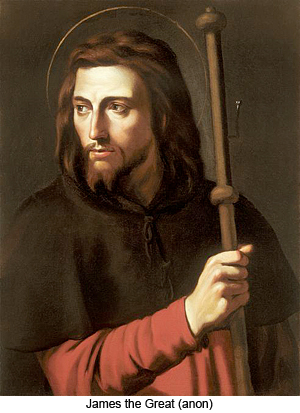 Fisheaters.com tells us, “…tradition picks up again by telling us that James’s relics were translated to Spain (of course, legends grew surrounding the event, one strange and lovely one in particular apparently meant to explain why the cockleshell is St. James’s emblem. It is said that when the Saint’s relics were being conveyed by ship from Jerusalem and approached the coast of Portugal, a man happened to be riding his horse on the beach. The horse disobediently plunged into the sea, with its rider, making for the boat. They sank, of course, but then rose again, covered with scallop shells, and hence the cockleshell became the symbol of our hero).”
Fisheaters.com tells us, “…tradition picks up again by telling us that James’s relics were translated to Spain (of course, legends grew surrounding the event, one strange and lovely one in particular apparently meant to explain why the cockleshell is St. James’s emblem. It is said that when the Saint’s relics were being conveyed by ship from Jerusalem and approached the coast of Portugal, a man happened to be riding his horse on the beach. The horse disobediently plunged into the sea, with its rider, making for the boat. They sank, of course, but then rose again, covered with scallop shells, and hence the cockleshell became the symbol of our hero).”
St. James is the patron Saint of Spain, but was also dear to Christians in England, including the characters in my new book; the hero and heroine are each from families dependent upon the high seas. Fisheaters.com continues, “…the people of England who couldn’t make the pilgrimage to St. James’s shrine would gather up seashells, bits of broken colored glass, pretty stones, and flowers and such and would build little grottoes in honor of St. James on his Feast. It is also customary for the English to eat oysters that day… In France, it is not the oyster that is eaten, but the scallop – named “Coquilles St. Jacques” – “shells of St. James” – in his honor.
Here’s a tiny excerpt from Bride of a Distant Isle. I hope you’ll read it to see if Annabel gets her pearl!
“I’ve eaten too many oysters,” I admitted. “You know it’s been said that whoever eats them on Saint James’ Day shall never want. At this moment, I feel I shall never want of another oyster.”
He laughed and led me toward an arrangement of chairs near the Edge of the World, where we could best see the horizon, the cloud-pebbled sky as it married the bright water. I did not look down, though, where quicksand waited to catch whoever fell in its malevolent arms.
“You are so partial to oysters?”
“No,” I admitted. “Though I can better tolerate the ones doused in garlic and butter.”
“Why so many, then?” He waited for me to settled down, comfortably, on the best of the small group of seats assembled.
“Pearls, Captain Dell’Acqua. Chef has told me one must open at least 100 oysters to find a pearl. Every year I try to find one.”
April 20, 2016
Christian Fiction Scavenger Hunt Stop #7
Welcome to the Christian Fiction Scavenger Hunt!
If you’ve just discovered the hunt, be sure to start at Stop #1, and collect the clues through all 33 stops, in order, so you can enter to win one of our top 3 grand prizes!
• The hunt BEGINS with STOP #1 at Lisa Bergren’s site.
• The hunt is BEST VIEWED using Chrome or Firefox as your browser (not Explorer)
• It is open to INTERNATIONAL entrants.
• PRIZES include 3 sets of all 32 books, $500 in Amazon gift cards and many authors are offering additional prizes!
• There is NO RUSH to complete this hunt—you have ALL WEEKEND. So take your time, reading the unique posts along the way; our hope is that you discover new authors/new books you might want to learn more about!
• Submit your ENTRY for the GRAND PRIZE at STOP #33 (back on Lisa’s site) by Monday night (4/25) at Midnight, Mountain time. Introducing Lyn Cote
Introducing Lyn Cote
I’m delighted to introduce the prolific, wonderful author, Lyn Cote to you. Lyn and I are publishing “sisters” of a sort, as we share the same agent. Lyn is a master of the romantic storyline, but I also appreciate that she brings light to unusual, but fascinating, topics, like Quaker women.
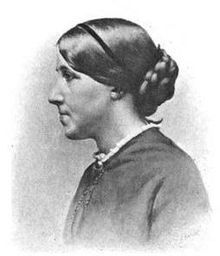 Louisa May Alcott, Civil War Nurse
Louisa May Alcott, Civil War Nurse
By Lyn Cote
Most of us who love American fiction are acquainted with the 19th century author Louisa May Alcott’s Little Women. But few realize that this famous author served for a brief time as a Civil War nurse.
At the outbreak of the war in 1861, she longed to do more than gather clothing for the war effort.
On her 30th birthday on November 29, 1862, she made up her mind to do more. She recorded in her journal, “Thirty years old. Decide to go to Washington as a nurse if I could find a place.” She received her orders on December 11 and made her way to Georgetown, outside of Washington, D.C.
While there, she caught typhoid fever and was treated with calomel, a form of poisonous mercury. She survived but later wrote, “I was never ill before this time, and never well afterward.”
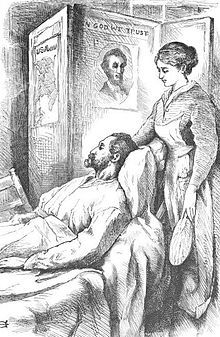 While serving as a nurse, Alcott wrote several letters to her family in Concord, Massachusetts. In response to urging, she decided to publish them after slightly revisions and fictionalizing them. The narrator of the stories is named Tribulation Periwinkle but the sketches are authentic, reflecting Alcott’s real experiences. Hospital Sketches was very popular and some of each copy went toward the support of war orphans.
While serving as a nurse, Alcott wrote several letters to her family in Concord, Massachusetts. In response to urging, she decided to publish them after slightly revisions and fictionalizing them. The narrator of the stories is named Tribulation Periwinkle but the sketches are authentic, reflecting Alcott’s real experiences. Hospital Sketches was very popular and some of each copy went toward the support of war orphans.
I read Ms. Alcott’s book, Hospital Sketches, while preparing to write my latest book, FAITH, the third and final story in my Quaker Brides series. This series follows one family’s involvement from 1820 when the Underground Railroad sprang to life (HONOR Book 1), through the years of the fight for abolition (BLESSING Book 2) to finally the war that ended slavery (FAITH, Book 3).
In preparing to write this book, I read several diaries and accounts by other Civil War nurses, but it was obvious to me that Louisa May Alcott was the only one who knew how to write in a way that portrayed the suffering of wounded soldiers and had the ability to touch hearts. I came away, amazed that anyone would put themselves in the way of bullets when so little medical help was waiting for them if they were wounded.
Hospital Sketches is in the public domain. If you’d like to download a copy, here is a link.

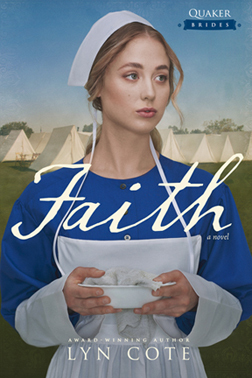 Faith
Faith
The Civil War battlefield is the last place Quakeress Faith Cathwell thought she’d find herself. But with a gift for nursing, Faith seizes this opportunity to join the fight for abolition―and to search for Shiloh, a freeborn childhood friend who was kidnapped and sold south by unscrupulous slave catchers.
Knowing it’s much too dangerous for her to search enemy territory alone, Faith enlists the help of Colonel Devlin Knight, who is indebted to her for saving his cousin’s life. A career soldier, Dev is committed to the preservation of the Union but conflicted about freeing his own slave and confidant, who plans to enlist as soon as Dev gives him manumission papers.
Blazing a trail east with the rest of Grant’s army, Dev and Faith fight their personal battles―and a growing attraction to each other. When beliefs clash and passions flare, they quickly find that the only thing more dangerous than the war surrounding them is the battle within their hearts.
 To read an excerpt of FAITH or to purchase, visit http://booksbylyncote.com/SWBS/new-book-release/the-beginning-of-faith-book-3-of-my-quaker-brides-series
To read an excerpt of FAITH or to purchase, visit http://booksbylyncote.com/SWBS/new-book-release/the-beginning-of-faith-book-3-of-my-quaker-brides-series

Here’s the Stop #7 Skinny:
You can order Lyn’s book on AMAZON | BARNES & NOBLE | CBD or at your local bookstore!
Clue to Write Down: peculiar
Link to Stop #8, the Next Stop on the Loop: Lyn Cote’s own site!
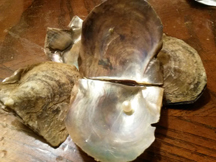 BEFORE YOU LEAVE!!
BEFORE YOU LEAVE!!
Do you, too, want to find a pearl, like Annabel does in my new release, Bride of a Distant Isle?
Sign up for my newsletter, here, and commit to receiving the newsletters no more than every other month for a year. Then comment, below. Two names drawn from those commenting will win an “open your oyster, find a pearl inside!” (picture used with permission)
March 21, 2016
Maltese Pastizzi
The island-bound Maltese are famous for their tasty little pastry boats. These are most often filled with a blend of cheeses, and perhaps peas. My family enjoyed them just a little sweeter, with strawberry jam on top. The beautiful thing is – the recipe is so accommodating. So try them once, and then adjust to taste!
· Preheat oven to 400
Ingredients
One sheet of frozen puff pastry dough
One cup whole milk ricotta cheese, softened
2 T sugar
2 eggs
Let the puff pastry come to room temperature according to the directions on the box. Roll out to about ¼ inch thickness. Using a biscuit cutter, cut the dough into circles about 4” across.
Place the circles onto a baking sheet which has been lined with parchment paper. Then, pinch together the ends of each circle, causing the pastry to look like a canoe or little boat.
Mix, with a fork and until thoroughly blended, the ricotta, the sugar, and one egg. Whip, the second egg in another bowl, to be brushed onto pastries.
Spoon cheese mixture into the “boat” of each pastry until it is nearly filled.
Brush each boat with the beaten egg, and place in oven for about 20 minutes until pastry is completely cooked and the tops are golden brown.
Serve – and enjoy!!
Honey Amber Prize Candle Giveaway!
If you’ve read Bride of a Distant Isle, you’ll know that both honey, and amber, play an important role in the story. Haven’t read it yet? Don’t wait! To set the mood while you read, please enter to win one of two Honey Amber Prize candles. There is a ring in each candle, a treasure to find once you’ve enjoyed the sweet scent. Will your ring be worth $10 – or $100? I don’t know, but you can find out if you win!
To enter, please leave a comment below about the dream vacation you still hope to take.
January 27, 2016
Visit Malta
January 25, 2016
Catholicism in England, Briefly
Christianity is said to have been established in England in the first or second century; of course, Christianity at that time meant, for the most part, the faith as celebrated by the Roman Catholic Church. Although there were dissenters throughout the centuries, the Catholic Church remained the official church of England until Henry VIII famously broke with Rome in 1534 to establish the Church of England. Following that, all religious properties in England became properties of the crown. Many of those properties—lots of land and grand houses—were distributed to friends and supporters of the king. Their families and heirs then inherited them throughout the ages. It is for this reason that many noble houses have names that include religious terms such as, “Abbey” in them.
Henry’s daughter Queen Elizabeth I tried to walk the via media, the middle ground between Protestantism and Catholicism and was tolerant of Catholic worship as long as it did not become treasonous. When it did become treasonous, she acted swiftly. Highly born Catholics were mostly safe, and some retained power and influence in every age and era. However, commonly born Catholics and those in the middle social status were routinely punished.
According to One Hundred and Fifteen Years A-Growing: The Story of the Catholic Parish of Lymington, “From 1577 the authorities decided to impose more severe measures for disobeying the religious laws of the land. These included a £5 fine, equivalent to £1000 today (about US $1500) for non-attendance at a Protestant Sunday service.”
James I, who succeeded Elizabeth I, was even more staunchly Protestant than she. It was this King James who commissioned the King James Bible. In spite of a few ensuing years with a Catholic monarch, (notably, James II, 1685-1688) Britain remained strictly Protestant. “The Act of 1700 provided rewards to spies and informers against Catholics…” according to A-Growing, which also tells us that, “The New Marriage Act of 1753, compelled Catholics to marry in the Protestant Parish church to legalize the marriage. This rule continued until the early days of Queen Victoria’s reign.” Catholic couples were often married in their own faith, and then “remarried” to comply with the law.
Change was coming, but slowly. A-Growing states that the”…Catholic Relief Act of 1788 enabled Catholics to buy and inherit legally, and it was no longer an offense punished with life imprisonment to exercise the functions of a Catholic Priest, or run a Catholic school.”
The Catholic family upon which I very loosely based the Somerford family were the generous Welds. Mr. Thomas Weld of Lulworth Castle bought Pylewell House (Milford on Sea) in 1801 for the use of his son Joseph. He was also a founder member of the Royal Yacht Squadron. A-Growing confirms, “A year or so after the Welds first took over Pylewell House, a large ground floor room at the south end of the house was converted into a chapel where Mass and other services could be held… The chapel was available for all the local Catholics, both estate and employees, and others living nearby.” Indeed, chapels were set up in private homes all across England for just such a purpose.
It was true that some priests also served as chefs, or butlers, in order to be legally present and indistinguishable in Catholic households. A-Growing informs that, “Some other Catholic landowners in this district… often employ(ed) a man in their household who was, in reality, an ordained priest, and could minister to their spiritual needs.”
The Emancipation Act of 1829 brought more freedoms, including assuring Catholics the freedom to vote and hold office, and freedoms slowly returned to England’s Catholic subjects. Prejudice, however, remained strong throughout the 19th century. Although religious tolerance is commonplace and widely practiced in England today, as in many places around the world, England remains officially Church of England.
Photo of stained glass at Winchester Cathedral courtesy of Wikimedia Commons.
Victorian Era Insane Asylum
The Trans-Allegheny Lunatic Asylum listed some reasons for admission from 1864-1889.

Asylum pictured is European, courtesy of iStock Photos.
Susan, Bride
“Bride of a Distant Isle is an absorbing, transportive Victorian romance infused with intriguing details and delicious imagery. Sandra is a master of the historical novel. Engaging to the last page.”
~ Susan Meissner, Author of Secrets of a Charmed Life
Katherine Reay, Bride
“Lovers of wind-swept moors and Bronte-esque intrigue will devour Byrd’s latest romance, Bride of a Distant Isle! Annabel Ashton, like Jane Eyre before her, doesn’t accept her circumstances or let mysteries rest unsolved, but instead invites you along as she proactively uncovers truths and searches out her own happily ever after.”
~Katherine Reay, author of The Bronte Plot



